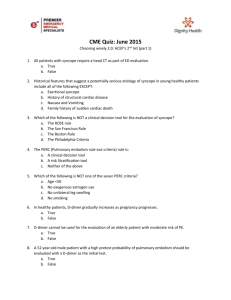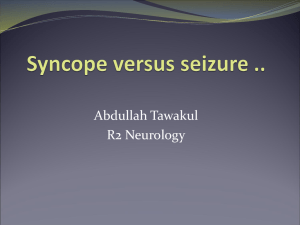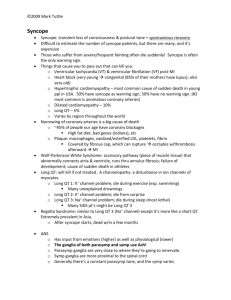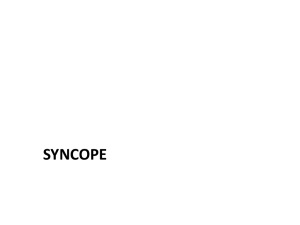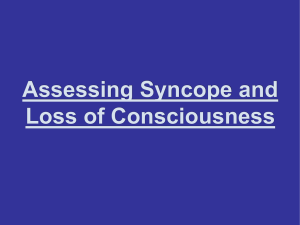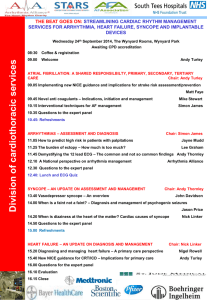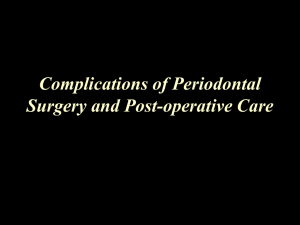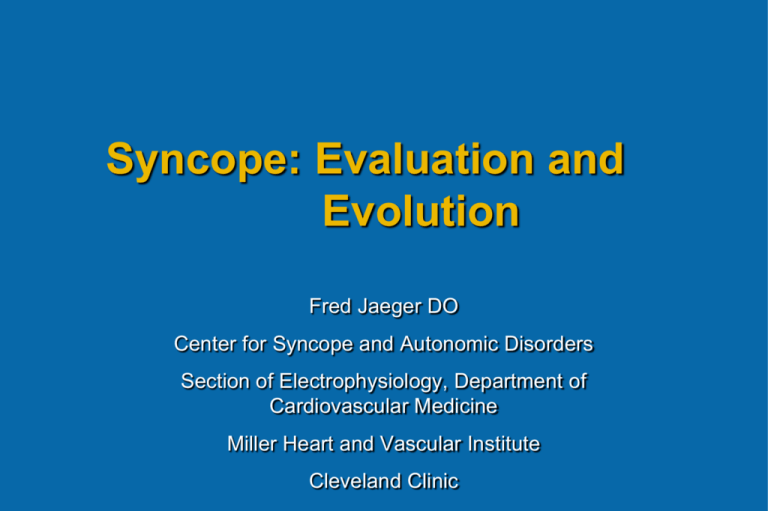
Syncope: Evaluation and
Evolution
Fred Jaeger DO
Center for Syncope and Autonomic Disorders
Section of Electrophysiology, Department of
Cardiovascular Medicine
Miller Heart and Vascular Institute
Cleveland Clinic
Syncope – What’s New?
What’s Trending?
• Specialized Treatment Centers
• Expedited REVEAL/ILR implantation “LINQ”
•
•
•
•
•
Genetic basis for Vasovagal Syncope
Vasovagal Syncope Prophylactic Medication Clinical Trials
Evolution Of Pacemaker Therapy for Vasovagal Syncope
Early Repolarization – Not always benign
New Entities “Paroxysmal AV Block” and “Sudden Syncope
with Normal Heart”
• What’s new in syncope at Cleveland Clinic?
• Obamacare!
Syncope - What’s New?
Affordable Health Care Act - Healthcare Evolution
• Perfect Storm of limited resources, declining reimbursement
but greater access for the syncope patient
•
•
•
•
PCPs will likely be on the frontline
Declining Reimbursement ICD-9-CM code 780.2
Fear of Limiting Specialty and Subspecialty access
Tighter regulation on testing, e.g Tilts not covered by many
insurance plans
• Population continues to age, syncope incidence will likely
increase
• Need for streamlined approach
• Costs are skyrocketing “Every test for every patient” will
bankrupt the medical system eg Evolving and expanding
indications for ICD for primary prevention
“…cardiac syncope can be a harbinger of sudden
N Engl J Med. Sept. 19, 2002
death.”
• Framingham study
Survival with and
without syncope
• 6-month mortality
rate of greater
than 10%
• Cardiac syncope
doubled the risk
of death
Soteriades ES, et al. NEJM . 2002;347:878-885.
Syncope – Multiple Layers of Risk
• Mortality versus morbidity
• Long term risk versus short term
• Risk of Sudden death due to underlying SHD
• Risk of injury due to syncope eg syncope while on coumadin,
syncope while driving, high risk occupation
• QOL – fear, anxiety, disability from syncope
Risk Considerations
• National and International guidelines not specific on
who should see the patient
• Emphasize need for streamlined algorithm or “ Care
Path” Future incorporation into EHR
• Quality of Life concerns – driving occupation, safety,
fear. Even a single episode of syncope can have a
major life impact
• Recalcitrant/recurrent cases may require Tertiary
care center/specialized syncope centers with
multidiscipline approach eg, internists, neurologists,
cardiologists, Electrophysiologists, gerontologists
Syncope - Epidemiology
• Up to 60% of the population may have syncope in their
lifetime.
• 500,000 new patients per year
• Many people with syncope don’t seek medical attention
until it recurs, estimated to be almost 50%.
• Many patients forego ED and present to PCP
• 1-3% of ED visits
• 40% of ED patients are admitted, average LOS 5.5 days
• Staggering Health Care Cost - $2.4 Billion annually
• Syncope most common in flight emergency
What’s new in Syncope – Syncope Centers
• Specialized multi-discipline centers for rapid evaluation and
triage of patient’s with syncope
• Fits and Faints,Falls, Fractures
• Initial contact through emergency department
• Rapid access to syncope specialists EEG cardiologists,
internists, electrophysiologists
• Rapid risk assessment, and identification of high risk patients
requiring in-hospital evaluation andtreatment, such as
pacemakers, defibrillators, EP studies, cardiac cath etc.
Utah/Wisconsin Falls Fainting Clinic
Hamdan PACE 2013
Syncope - Definition
Transient Loss of Consciousness, loss of postural muscle
tone due to Pan- Cerebral Hypoperfusion with complete
recovery without Focal Neurologic Deficit
Excludes Seizures, TIA/ CVA, Metabolic etiologies,
Psychogenic, Trauma, Sleep Disorders, Intoxication,
Hypoxemia, Migraines,Hyperventilation
Part of the spectrum of ”TLOC” - Transient Loss of
Consciousness
Syncope – Epidemiology
Emergency Department
• 45% Males
• Bad prognostic sign - 0.7% die within 7-30 days,
10% die within a year
• Severe nonfatal outcomes, including injury from
syncope recurrence, major intervention, new
serious diagnosis - 8% while in ED, 5% in next 730 days
Syncope – Evaluation in the Emergency Department
• Previously very heterogeneous in their approach
With divergent tests such as chest CT to rule out
dissection or pulmonary emboli
• Extensive laboratory, cerebrovascular imaging,
cards and neuro consultations, MRIs
• Admission was seemingly recommended
haphazardly
• Classic neurally mediated or vasovagal syncope
were eventually discharged in recommended
followup with PCP or occasionally cardiology
Prognosis Among Healthy Individuals
Discharged With a Primary Diagnosis of Syncope
• 37,017 patients seen in Denmark ED for new syncope without
apparent heart disease or diagnosis
• Compared to non syncope controls
• Followed for death, recurrent syncope, PPM,ICD or stroke
• Syncope had double the mortality during follow up
• 25 to 75 y/o had significantly higher mortality and risk of
cardiovascular event
• Speculation that syncope may be frequent cause of fatal
accidents, MVAs,
“Low Risk is Not No Risk”
Ruwald JACC 2013
Syncope: Etiology
NeurallyMediated
1
• Vasovagal
• Carotid Sinus
• Situational
Cough
Postmicturition
24%
Orthostatic
Cardiac
Arrhythmia
2
• Drug
Induced
• ANS
Failure
Primary
Secondary
11%
3
• Brady
Sick sinus
AV block
• Tachy
VT *
Structural
CardioPulmonary
4
• Aortic Stenosis
• HOCM
• Pulmonary
Hypertension
SVT
NonCardiovascular
5
• Psychogenic
• Metabolic
e.g. hyperventilation
• Neurological
• Long QT
Syndrome
14%
4%
12%
Unknown Cause = 34%
DG Benditt, UM Cardiac Arrhythmia Center
Causes of Syncope
•
Cardiac
Arrhythmic
Nonarrhythmic
Non-cardiac
Bad Things are Relatively Rare but We always Worry about them!
Potentially Fatal Causes for Syncope
•
•
•
•
•
•
•
•
HOCM
Wolff-Parkinson –White
Myocardial Ischemia/Infarction
Pulmonary Embolus
Long QT Syndrome
Brugada Syndrome
Arrhythmogenic RV dysplasia
Catecholaminergic Polymorphic
Ventricular Tachycardia(CPVT)
• Aortic Stenosis
• Dissection
• Stroke/TIA/ Cerebral Hemorrhage
Causes of Syncope by Age
Younger Patient
Older Patient
• Vasovagal
• Psychiatric
• Cardiac**
– Mechanical
– Arrhythmic
• Long QT*
• Orthostatic hypotension
• Brugada syndrome*
• Drug-induced
• WPW syndrome*
• Neurally mediated
• Situational
• RV dysplasia*
• Hypertrophic cardiomyopathy*
• Catecholaminergic VT
• Other genetic syndromes
• Multifactorial
Underlined: benign
*Rare, not benign
**Not benign
Olshansky B. In: Grubb B and Olshansky B. eds. Syncope: Mechanisms and Management. Futura. 1998:15-71.
Syncope in the Elderly
• Multifactorial
• Medications- vasodilators, diuretics, BB’s
• SSS,CSM
• Unexplained falls - Retrograde amnesia - “ Fits Falls Fractures
Clinics”
• Impaired autonomic reflexes - Post Prandial drop in BP due to
splanchnic sequestration - “Pizza Tilt”
“Spell”
Unexplained altered or
loss of consciousness
Approach
to Syncope
History
Physical (Cardiac-Neurologic)
ECG
Probable Clinical Diagnosis
2 Neuro-Regulatory
Head-up tilt
Hemodynamics
Blood Volume
Autonomic Testing
Carotid Sinus Massage
1
Cardiac
Arrhythmias Obstructive
3
Neurologic
Consultation
Cardiac Risk Factors?
EEG
- LV dysfunction
- Cardiac Cath
CT scan
- Abnormal ECG
Other tests
Echocardiogram
- - Older Patients
as appropriate
- ASHD
Cardiac
- Extended ECG
Return
Monitoring
Electrophysiology
to 1 or 2
Return
to
1,2
or
3
Study
Presumptive Diagnosis with Clinical Correlation
Definitive Diagnosis
Appropriate Therapy
From: New Concepts in the Assessment of Syncope
J Am Coll Cardiol. 2012;59(18):1583-1591. doi:10.1016/j.jacc.2011.11.056
Figure Legend:
The Diagnostic Algorithm of a Patient Presenting With TLOC of Suspected Syncopal Nature
For explanation, see text. ECG = electrocardiogram; TLOC = transient loss of consciousness.
Date of download:
10/5/2013
Copyright © The American College of Cardiology.
All rights reserved.
Syncope – Risk Stratification
Two immediate questions to consider for
First Responder
• Can the syncope be a warning sign for future sudden
cardiac death?
• What is the risk of recurrence of the syncope and severe
physical injury?
Syncope
History!
History!!
HISTORY!!!
Syncope – Initial Assessment
• History/ Physical
• Orthostatics – standing BP/HR immediate, 1 minute and
3 minutes( or longer for covert OH)
• EKG
• Echo +/- Stress
• Lab, esp CBC,Lytes
• Holter/ Ambulatory monitoring
• Tilt if suggestive of VVS, POTS, Dysautonomia
•Admit, Reassure or Refer
•Cardiology/EPS Referral – Cath, EP study, ILR
History
• Position/posture
• Vision/Smell/Sound
• Frequency
• Duration
• Pain,Headache
• Vagal symptoms – Diaphoresis, Nausea,
Emesis,Pallor,Cyanosis
• Prodrome/warning? Angor Animi
• Sequelae - Confusion? Post ictal? Instant Recovery?
• Injuries
• Witnesses - Movement of head, trunk, extremities?
Sustained or Brief?
• Tongue biting, incontinence
Cough/Tussive Syncope
• Cardiopulmonary Baroreflex with vasodepression, occassional
pauses, bradycardia, AV block,? Elevation of CSF pressure
• Search for ENT/pulmonary cause
• Treatment: cough suppression, aerosol Lidocaine
High Risk /Malignant Syncope/Red Flags
• CHF, CAD, DM, Cardiac Risk Factors
• Abnormal EKG
•
•
•
•
•
•
•
Injuries
No apparent noxious stimuli/precipitating event
No warning/ Minimal Prodrome
Syncope while Driving
Palpitations prior or after (Vagal Atrial Fibrillation,Arrhythmias)
Chest pain before or after, Dyspnea
Syncope with exercise ,especially during ( syncope in
recovery could be autonomic)
• Medical Dx ie Sarcoid, Lymes, Dystrophies
• High Risk occupation
Syncope – Low risk
• Previous Multiple Syncopal events
• Normal EKG
• Normal Physical
• Normal Echo
• No history structural heart disease or arrhythmias
• Typical vagal symptoms
Syncope – Predicting Recurrence
• Of all comers 33% will have recurrence in 3 years
• Age over 40 but low risk – up to 20% recurrence at
2 years
• 3 previous life time syncope – 42% at 2 years
• High number of syncope episodes suggest reflex
syncope
• Extreme number suggest Pseudosyncope
Syncope
Value of History in Differentiation
• 80 patients with syncope
–32 neurocardiogenic
–16 AV block
–32 ventricular tachycardia
• Age 58 + 17 years
• All underwent comprehensive questionnaire
Calkins AJM 1995
Syncope Due to AV Block or VT
• ≤ 2 episodes of syncope
• Male sex
• Warning ≤ 5 seconds
• Age >54 years
Calkins AJM 1995
Syncope Due to NCS and not due to VT/AV
Block
• Prior to Syncope
–Palpitations
–Blurred vision
–Nausea
–Warmth
–Diaphoresis
–lightheadedness
Calkins AJM 1995
Syncope Due to NCS and not Due to VT/AV Block
• Following Syncope
–Nausea
–Warmth
–Diaphoresis
–Fatigue
Calkins AJM
1995
Syncope - Clues from the History
• Family History of SCD = LQTS, Brugadas, HCM,
ARVD/C ? Drownings, ?MVAs
• Tongue biting, incontinence = Seizure
• Motion sickness, migraines, childhood fainting, athlete,
hypervagotonia, early repolarization on EKG, Family
Hx of fainting, phobic/pain fainting = Vasovagal
• Head turning = Carotid sinus syndrome
• Many episodes, vagal symptoms, prolonged warning,
= Vasovagal
“Status Vasovagalis”
• No prodrome, no symptoms post , Male sex, first
episode over age 55 = AV block or VT
Orthostatic Hypotension
• Syncope in AM, with rapid standing,
post prandial
• Systolic drop 20-30 mmHg ,
diastolic drop 10 mmHg or SBP< 90
although usually much more clinically
• Most common secondary causes –
DM, Medications, Volume depletion
• Primary autonomic failure relatively
rare and usually obvious - Parkinsons,
cancer/paraneoplastic,
Multi System atrophy (Shy –Dragger)
LQTS
Deglutition/ Swallow Syncope
ARVD – Arrhythmogenic Right Ventricular
Dysplasia
• RBBB/ epsilon waves, t - wave abnormality “juvenile t wave pattern”
• Fatty - fibrous infiltration of right ventricle
• Characteristic findings of fatty infiltration on
CT/MRI
• Syncope due to SMVT or PMVT
• Genetic testing
• ICD, AAD, RFA if syncope or SCD
Brugada’s Syndrome
• Channelopathy with VT/VF
• RBBB and ST segment elevation in anterior precordial leads
• Genetic testing – Familion
• Flecainide or Procainamide challenge
Intensive Review of Cardiology
Trifasicular Block – RBBB,First degree AV block,LAHB
Intensive Review of Cardiology
Syncope – EKG monitoring
•
Holters – useless unless something happens
•
Event recorders - continuous loop recorder
•
Implantable
– Reveal and Confirm - inplantableloop recorder
– Pacemakers/ ICDs with wireless transmission
•
Ambulatory Wireless long term monitoring for
diagnosis/prevention – MCOT (Mobile Cardiac Outpt
Telemetry) continuous loop recorder using cellular
networks, bluetooth e.g. Cardionet, Lifewatch
•
Future devices will incorporate BP,O2 etc
Cardionet
Wireless Ambulatory ECG
Monitors
• CardioNet , Lifewatch, others
• Automatic/ Patient activated
• External 3 Lead/Portable Monitor Wireless Connection to Service
• GPS Capable, Altimeter
• Aimed at Low Risk Patient - Not in 911 business
– Atrial fibrillation
– SVT
– SSS
– Syncope of Undetermined Origin
– Cryptogenic Stroke
– Refractory Seizures
Ambulatory Monitoring - Summary
• Choose monitor likely to have highest yield.
• Pts with daily events, palpitations, syncope/ near
syncope, holters frequently are sufficient.
• Weekly or monthly events use wireless monitors
• Pts with rare events, consider referral for Implantable
Loop recorders.
• Elderly, No prodrome or no warning, prolonged spells,
solitary, Use wireless or implanted loop
• Valuable if symptoms but NSR, Sinus Tachycardia. Tells
you what its not.
Reveal/Reveal Plus/ DX /XT - Medtronic
Insertable Loop Recorder -ILR
• Records EKG – not electrogram
• Minimal Incision – Low Risk
• Appropriate Patient Selection –early utilization
– Syncope in Normal Hearts
– Fleeting Suspected SVT’s
– Drug Refractory Seizures
– Cryptogenic CVAs
• Inappropriate for High Risk Patients
– Severe LV/Post MI
– VT Suspected
– Structural Heart Disease
Osman,PACE 2005
Syncope Strategies – Cost Comparisons
• Sixty Pts recurrent syncope, normal LV function.
• Randomized to Tilt, EPS ( Conventional) versus Loop
recorder.
• Crossover at one year if no diagnosis.
• 47% diagnosed with ILR, $2731 per Pt, $5852 per diagnosis
• 20% conventional approach, $1683 per Pt, $8414 per
diagnosis
• Higher yield more cost effective with Loop recorder
Syncope Strategies – Cost Comparisons
Krahn JACC 2003
Medtronic Reveal LINQ
ISSUE 3 – ILR Guided Pacemaker Implantation
Brignole Circulation 2012
International Study of Syncope - Issue 3
•
•
•
•
511 patients with recurrent syncope suspected to be vasovagal
All underwent Implantable loop recorder
89 patients had recurrent syncope with pauses
79 patients received Pacemaker implant if documented pauses>3
seconds if symptomatic or >6 sec pause if no symtpoms
• Pacemaker programed on or off
• 57% recurrence with PPM off
• 25% recurrence with PPM on
Brignole Circulation 2012
Limitations of ISSUE 3
• Variability of cardioinhibitory responses
• Only 10% were found to have pauses during study
• Doesn’t address the vasodepressor response
• Role of rate drop / What type? Hysteresis? CLS?
Non Ischemic Dilated Cardiomyopathy and
Syncope
• Portends a high mortality
–(45% at one year)
regardless of cause
• EPS for SMVT - often
unrevealing/non predictive
• No prospective studies of “Empiric
ICD”
• Now Moot by Definite, SCD-Heft
Syncope
• Indications for EPS
– Prior MI
– LV Dysfunction/Cardiomyopathy Moot by Definite SCDHeft
– Wide QRS – LBBB/RBBB, ?Brugadas
– Systemic Illness
–Sarcoid
–Lymes
– Prolonged PR, Mobitz 1
– “Complex” Ventricular Ectopy – NSVT
– SVT, Delta Wave
– Family HX of SCD
– Palpitations
– “Final Court of Appeals” Although EPS likely low yield in
normal hearts
• Vasovagal syncope
Neurally Mediated Syncope
• Carotid sinus syncope
• Tussive syncope
• Glossopharyngeal neuralgia / deglutition syncope
• Pallid breath holding spells
• Aortic stenosis
• Hypertrophic obstruction cardiomyopathy
• Pacemaker syncope
• Syncope secondary to pulmonary hypertension
• Micturition syncope
• Mess trick – Fainting Lark
• Diving reflex
• Syncope during Atrial fibrillation, VT and SVT may
have Neurally mediated contribution and
component
Vasovagal
Syncope
• Comprises significant proportion of
unexplained syncope
• 60% of population are estimated to have t least one episode
• ANS pertubations - Sudden
hypotension/bradycardia resulting in loss
of consciousness
• Presumed trigger is augmented inotropic,
chronotropic cardiac state
• Bezold Jarisch Reflex - sudden withdrawal of
sympathetic/heightened or unopposed vagal
• Episodes may cluster, the disappear for long intervals
Vasovagal Syncope: Features
• Crumple to ground - injuries are rare
• May recur
• Slow recovery- ” Vagal “ for hours
• Myoclonic jerking “anoxic seizure”,
Convulsive Seizure
• Diming of vision, “grey out”, Diaphoresis,
nausea, pallor, warmth
•
•
•
•
Hyperventilation - “shortness of breath”
Yawning, weakness
Palpitations, “chest pain”
Fight or Flight
Genetic Basis for Vasovagal Syncope
• Frequently multiple members of same family are fainters
• ? Nature or Nurture/State or Trait? “All in the Family”
• Berkovic found autosomal dominant vasovagal susceptibility
from loci on chromosome 15q26 (Neurology 2013 )
• Uncertain what these genes code for? Protein? ion channels?
Enzymes? Neurotransmitters? Cardiac, peripheral or CNS?
Vasovagal Syncope
• Benign/Situational
– Emotional faint
– Fear, pain - “The Paleolithic –Threat
Hypothesis” Darwinian Fitness
– Dentist,church,Restaurant,phlebotomy
• Malignant
– No recognized stimulus
– Little or no prodrome
– Prolonged asystole
– Injuries
– Social impact – Loss of Occupation, Driving
Malignant Vasovagal Syncope
Situations which Provoke Vasovagal Syncope
• Fear, anxiety, “flight or fight”, pain, venipuncture
• Pregnancy, standing “at attention”
• Hypovolemia, anemia, hemorrhage
• Head-up tilt, lower body negative pressure
• “First dose phenomena”, nitrates
• Beta-blocker withdrawal
• Prolonged bed rest, prolonged head down tilt, microgravity
Tilt Table Test
• Traditional research tool for postural effects on
BP and arrhythmias
• Control subjects with syncope were observed to
faint
• Maximizes venous pooling
• Provokes vasovagal syncope in susceptible
patients
Head Up Tilt: Indications
• Syncope of unknown origin
– Suspected vasovagal
• Syncope with observed SA
or AV dysfunction
– Extrinsic sick sinus
syndrome
• Seizures versus Syncope
• Pseudoseizure/Psychogenic Syncope
– Arterial line, Transcranial Doppler, EEG
• PAF with Syncope
l
Asystole and Convulsive Syncope During Head-up Tilt
A. Onset of Vasovagal Syncope
B. Prolonged Asystole
C. After IV Atropine
Tilt Table Testing Indications
Emerging Indications
• POTS – Postural Orthostatic Tachycardia
•
•
•
•
•
•
Syndrome, Dysautonomia
Orthostatic Hypotension,
Autonomic Insufficiency
Idiopathic Vertigo, Dizziness,
Lightheadness
TIA’s
Chronic Fatigue Syndrome, Fibromyalgia, Gulf war syndrome
Sudden Infant Death Syndrome (SIDS), Pallid Breath Holding Spells
Unexplained Falls
Not Warranted
Single episode in “classic” patient
Alternative specific cause demonstrated
Vasovagal Syncope
Tenets of Treatment
• Reassurance / Recognition / Avoidance
• Increase salt/ electrolyte fluids - 5-7 grams per day /
florinef
• Physical Countermeasure Maneuvers (PCM) Supine
position, Leg Crossing, Muscle tensing
Coughing
Circ 2002
• Jobst / physical therapy / Avoid deconditioning
• Serial tilt testing not predictive
• Tilt Table Training - Ector
Vasovagal Syncope
Medical Therapy
• Fludrocortisone Mineralocorticoid
• Disopyramide
• Serotonin reuptake inhibitors
- Sertraline, Fluoxetine
• Anticholingerics
Levsin, Transderm
scopolamine,Robinul
• Theophylline adenosine receptor
blockade
• Amphetamines, Ritalin
• Calcium channel
blockers
• Epogen, DDAVP,
Yohimbine,
Mestinon- Grubb
•International Goal for 2020 : Find a Proven Effective
Therapy for Vasovagal Syncope
Vasovagal Syncope Physical Counter pressure
Measures/Maneuvers(PCM)
• Arm and leg tensing, isometrics applied at prodrome
• Immediate increase in venous return, reduction of venous
pooling and possible autonomic effects
• Advise patient to get flat supine at earliest warning but
ultimately be effective upright, even during tilt (tilt training
effect?)
• Several studies have shown significant syncope recurrence
reduction.
Prevention of Syncope Trial (POST)
• Metoprolol versus Placebo in 208 patients with recurrent
Vasovagal syncope
• Syncope recurred in 75 patients
• No difference in therapy
• Metoporolol not effective
• Beta blockers now class 3 (no benefit) with ACC and
international guidelines
• Possible benefit in older patients, Patients >42 yo had
reduction of syncope recurrences (Sheldon Circulation 2012)
Sheldon Circulation 2006
Vasovagal Syncope – POST 2 Trial
• Randomized placebo control trial of Florinef in vasovagal
syncope
• 211 patients with recurrent vasovagal syncope randomized to
placebo vs florinef
• Endpoint was syncope recurrence ( not number of episodes)
• Data still being analyzed, but there was no statistically
significant syncope recurrence reduction but there was a
trend
• Likely may have benefit shown in young, non hypertensive
patients
• POST 4 - Randomized Trial of Midodrine
Raj Prog CV Dis 2013
Recurrent Vasovagal Syncope - Pharmacologic
Treatment
• Florinef if low Blood Volume
• Levsin for young, hypervagotonic pts
• Beta blockers if tilt suggests hyperadrenergic
state,hyperkinetic circulation
• Midodrine if low grade orthostasis, CFS, FM
• SSRI esp if additional DXs
Droxidopa – (Northera)
• Norepinephrine Precursor converted to Norepi by sympathetic
neurons
• Causes tremendous BP elevation, especially supine
• Approved by FDA in US Feb 18, 2014, anticipated availability late
2014
• Indications – severe persistent neurogenic OH from MSA,
Parkinsons, PAF
• May improve cognitive impairment through central enhancement of
Norepi
• Significant Risk of Severe Nocturnal HTN and Stroke/MI/Renal
failure. Monitor closely.
• Uncertain role for treatment of Reflex/Neurally Mediated Syncope
Syncope due to Idiopathic Paroxysmal AV Block
•
•
•
•
18 patient’s with recurrent syncope
Normal heart
Implantable loop recorders in most
Spontaneous third degree/complete heart block without
evidence of vagal stimulation
• Normal conduction system/Normal EKGs, normal PR and
QRS/normal His-Purkinje
• Etiology? Intrinsic AV node disease or autonomic reflex
Brignole JACC 2011
Syncope without Prodrome in Normal Heart and Normal
EKG
• A new distinct syncope entity, not typical vasovagal syncope
• Sudden onset of syncope, no warning or vagal symptoms
• Patients were generally older and Syncope started at older
age
• Decreased plasma adenosine levels
• Complex neurohumoral pathways
• May be related to idiopathic paroxysmal AV block and hence
benefit from pacemakers
Brignole JACC 2013
Natural History of
Neurocardiogenic Syncope
Spontaneous Resolution in Untreated Patients
Recurrence - Free Probability
100
80
60
40
20
0
0
2
4
6
8
10
12
Months
Natale, AJC 1995
Pacemakers for
Vasovagal Syncope
•
•
•
•
•
•
Cardioinhibitory response confirmed by loop recorder
“Highly” symptomatic, multiple episodes with injuries
Drug failures
Elderly – overlap with SSS, CSS
Rate drop / hysteresis /CLS
High risk occupations - Pilot / high steel / commerical
driver
Carotid Sinus Syncope
• Highest Incidence in Elderly
• Hypersensitive carotid sinus reflex with transient asystole
or AV block and hypotension
• Episodes occur with head turning, shaving, adjusting tie,
looking up, etc
• Treatment with PPM
• Testing with carotid sinus massage
• Amnesia of Event - “Fits, Falls, Faints and Fractures Clinic”
Patients with Syncope – Low Risk for death
• Remote episode without recurrence/ low risk patient
• Typical Benign Vasovagal episode known stimulus eg
sight of blood, pain, prolonged standing, dentist, church
• Reassure – prognosis is excellent
• Minimal workup - Normal EKG+/- Echo
• Severe orthostatic hypotension at bedside, although may
require multi discipline approach
Syncope – When to Admit for expedited evaluation?
• S. Francisco rule – CHF, Crit<30%, abnormal ECG, SOB,
Systolic<90 “CHESS”
• EGSYS, ROSE – Palps, syncope supine or during exercise,
High BNP, Low O2, Q waves, occult blood
• Structural heart disease – CAD, DCM, CHF, MIs
• Family history of SCD , HOCM, Brugadas Syndrome, DCM
• Conduction/Repolarization Abnormalities - Trifasicular
Block, LBBB, LQTS, Short QT syndrome, Early
Repolarization
• Features – sudden LOC without prodrome, MVAs, possible
SZs, Fractures, Head or bodily injuries, Chest pain or
exercise induced
Syncope – Risk Stratification “Higher risk”
Possible indication for admission or expedited workup
• Malignant Features of the Syncope
• Abnormal Holter / EKG/ Murmurs
• Suspected /Confirmed Vasovagal but Recurrent
• Cardiac Risk Factors
• Concerning Family History
• Occupational concerns
• Recurrent Unexplained falls especially in elderly
Syncope Additional Considerations for
expedited workup
• Patient Request
• Clearly Vasovagal but recurrent – Need for additional
treatment such as ILR/ pacemaker
• Medico legal: risk of bad outcomes is small but not zero
• 30-50% of syncope remains unexplained; suspected
vasovagal
• Driving – Guidelines are vague and inadequate
Syncope - What’s in the future?
• Fast track, guideline based syncope units
• Improved access
• Cost reduction
• Better outcomes
• Earlier utilization of Implantable loop
recorders, ultimately with BP monitors
Syncope 2020: Five Grand Challenges
• Learn the cause and integrated physiology of vasovagal syncope by 2020.
• Develop at least 1 effective treatment of moderately frequent vasovagal
syncope in patients without complications by 2020.
• Develop at least 1 effective treatment of vasovagal syncope in patients with
confounding comorbidities such as hypertension by 2020.
• Reduce yearly health care spending on syncope by 25% while improving the
diagnosis rate and patient satisfaction by 2020.
• Develop an individualized approach to most patients with syncope by 2020.
Sheldon Cardioloy Clinic 2013

